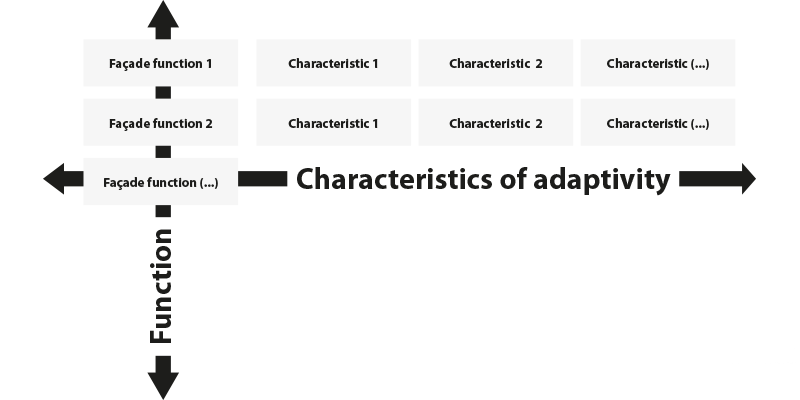Downloads
DOI:
https://doi.org/10.7480/jfde.2019.2.2463Keywords:
Intelligent building envelope, superposition matrix, adaptive façade, multi-functionality, intelligent technical systemAbstract
The environmental boundary conditions and the demand for comfort change constantly during the use of a building. By dynamically balancing changing conditions and requirements, adaptive façades contribute to the energy efficiency of buildings. The façade fulfils a multitude of functions that are interdependent and relate to environmental conditions and requirements. By negotiating mutually supportive and competing adaptive functions, intelligent coordination offers the potential for better performance of façades in building operation. The strategy is already being applied in other application areas, such as the intelligently cooperating machines in industry 4.0. There, individual automated production plants are networked to form intelligent technical systems with regard to a common production goal. The research presented follows the assumption that this strategy can be applied to automated and adaptive functions of the façade to increase the building performance. The study identifies those functions which, due to possible automation and adaptivity, as well as effect on performance, can be considered as possible components of an intelligently cooperating system. In addition, characteristics are determined which can be used to evaluate the extent of automation and adaptivity of an individual façade function. The study shows that the detailed analysis of the automation and adaptivity within identified façade functions is possible. With a superimposition matrix, it also provides a tool that enables this assessment of the degree of automation and adaptability.
How to Cite
Published
Issue
Section
License
Copyright (c) 2021 Jens Boeke, Ulrich Knaack, Marco Hemmerling

This work is licensed under a Creative Commons Attribution 4.0 International License.
Authors or their institutions retain copyright to their publications without restrictions.
References
Aelenei, L., Brzezicki, M., Knaack, U., Luible, A., Perino, M., & Wellershoff, F. (2015). COST Action TU1403 - Adaptive Facades Network.
Al horr, Y., Arif, M., Katafygiotou, M., Mazroei, A., Kaushik, A., & Elsarrag, E. (2016). Impact of indoor environmental quality on occupant well-being and comfort: A review of the literature. International Journal of Sustainable Built Environment, 5, 1-11. doi:10.1016/j.ijsbe.2016.03.006
Bitan, A. (1988). The methodology of applied climatology in planning and building. Energy and Buildings, 11, 1-10. doi:10.1016/0378-7788(88)90018-7
Bittencourt, L., Immich, R., Sakellariou, R., Fonseca, N., Madeira, E., Curado, M., . . . Rana, O. (2018). The Internet of Things, Fog and Cloud continuum: Integration and challenges. Internet of Things, 3-4, 134 - 155. doi:https://doi.org/10.1016/j.iot.2018.09.005
Böke, J., Knaack, U., & Hemmerling, M. (2018). State-of-the-art of intelligent building envelopes in the context of intelligent technical systems. Intelligent Buildings International, 1-19. doi:10.1080/17508975.2018.1447437
Dahl, T. (2010). Climate and architecture (1st ed ed.). Milton Park, Abingdon, Oxon ; New York, N.Y: Routledge.
Dumitrescu, R., Jürgenhake, C., & Gausemeier, J. (2012, 2012). Intelligent Technical Systems OstWestfalenLippe.
Fassaden: best of Detail -Facades. (2015). (C. Schittich, S. Lenzen, & I. f. I. Architektur-Dokumentation Eds. 1. Aufl ed.). München: Inst. für Internationale Architektur-Dokumentation.
Fortmeyer, R. M., & Linn, C. D. (2014). Kinetic architecture: designs for active envelopes. Mulgrave, Victoria: Images Publishing Group.
Givoni, B. (1976). Man, Climate and Architecture: Applied Science Publ.
González, B., Holl, C., Fuhrhop, D., & Dale, M. (2010). KfW Westarkade Frankfurt am Main energy-efficient office building. Berlin: Stadtwandel-Verl.
Hasselaar, B. (2013). The comfort unit: developed as part of a climate adaptive skin. ‘s-Hertogenbosch: Uitgeverij BOXpress.
Hausladen, G., de Saldanha, M., Liedl, P., & Sager, C. (2005). Climate design: solutions for buildings that can do more with less technology. Basel, Switzerland: Birkhäuser.
Hausladen, G., Liedl, P., & Saldanha, M. d. d. (2012). Klimagerecht bauen: ein Handbuch [Building to Suit the Climate: A Handbook]. Basel: Birkhäuser.
Hausladen, G., Saldanha, M. d., & Liedl, P. (2008). Climateskin: concepts for building skins that can do more with less energy. Basel ; Boston: Birkhäuser.
Herzog, T., Krippner, R., & Lang, W. (2004). Facade construction manual. Basel; Boston: Birkhauser-Publishers for Architecture.
Klein, T. (2013). Integral Facade Construction: Towards a new product architecture for curtain walls. doi:10.4233/uuid:f90c1c7e-b6b3-42de-8f17-22cc23981de7
Knaack, U., Klein, T., Bilow, M., & Auer, T. (2014). Façades: principles of construction (Second and revised edition ed.). Basel, Switzerland ; Boston: Birkhäuser.
Loonen, R., Trčka, M., Cóstola, D., & Hensen, J. L. M. (2013). Climate adaptive building shells: State-of-the-art and future challenges. Renewable and Sustainable Energy Reviews, 25, 483-493. doi:10.1016/j.rser.2013.04.016
Loonen, R. R., Rico-Martinez, J. M., Favoino, F., Brzezicki, M., Menezo, C., La Ferla, G., & Aelenei, L. (2015). Design for façade adaptability -Towards a unified and systematic characterization. Bern, Switzerland.
Moloney, J. (2011). Designing Kinetics for Architectural Facades: State Change: Routledge.
Monostori, L. (2014). Cyber-physical Production Systems: Roots, Expectations and R&D Challenges. Procedia CIRP, 17, 9-13. doi:10.1016/j.procir.2014.03.115
mppf - The multifunctional plug&play approach in facade technology. (2015). (T. Mach, M. Grobbauer, W. Streicher, & M. J. Müller Eds.). Graz: Verl. der Technischen Univ. Graz.
Ochoa, C. E., & Capeluto, I. G. (2008). Strategic decision-making for intelligent buildings: Comparative impact of passive design strategies and active features in a hot climate. Building and Environment, 43, 1829-1839. doi:10.1016/j.buildenv.2007.10.018
Rajkumar, R., Lee, I., Sha, L., & Stankovic, J. (2010, 2010). Cyber-physical systems: The next computing revolution. Paper presented at the Proceedings - Design Automation Conference.
Ranft, F., & Frohn, B. (2004). Natürliche Klimatisierung [Natural climatisation]. Basel: Birkhäuser.
Ross, A. M., Rhodes, D. H., & Hastings, D. E. (2008). Defining changeability: Reconciling flexibility, adaptability, scalability, modifiability, and robustness for maintaining system lifecycle value. Systems Engineering, 11, 246-262. doi:10.1002/sys.20098
Schumacher, M., Schaeffer, O., & Vogt, M.-M. (2009). Move: dynamic components and elements in architecture. Basel : London: Birkhäuser ; Springer [distributor].
van den Dobbelsteen, A., van Timmeren, A., & van Dorst, M. (2009). Smart Building in a Changing Climate: Techne Press.
Wang, L., Torngren, M., & Onori, M. (2015). Current status and advancement of cyber-physical systems in manufacturing. Journal of Manufacturing Systems, 37, 517-527. doi:10.1016/j.jmsy.2015.04.008
Winterstetter, T., & Sobek, W. (2013). Innovative and energy-efficient Façade technology for the KfW Westarkade Highrise in Frankfurt/Main. Stahlbau, 82, 35-46. doi:10.1002/stab.201390076
